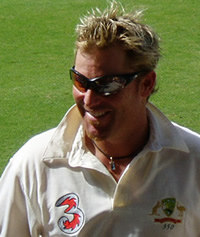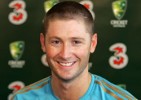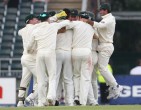Australian Spin – In Trouble
Corey Taylor |
The retirements of Shane Warne and Glenn McGrath after the final Ashes Test last season afforded the Australian team a duality of time for meditation on their immense achievements and on who would take their places in the team. The Australian team has found itself without both a pace bowling spearhead and spinner, 1200+ Test wickets between them as well as intangibles such as leadership, experience and bragadoccio, important components of any champion team.
The response to McGrath’s abdication has been swift; bowlers within the Australian squad have been encouraged to step-up and have distinguished themselves as skilful performers against strong opposition. Brett Lee is the most in-form fast bowler in world cricket. He has been well supported by a rapidly improving Mitchell Johnson and metronomic Stuart Clark. Coupled with this has been the outstanding form of several domestic fast bowlers who have made life, and scoring, very difficult for Pura Cup batsmen this year.
Atop the wicket-taking list are experienced first-class cricketers such as Doug Bollinger, Ashley Noffke, Matthew Inness and Gerard Denton. Younger bowlers such as Shaun Tait, Peter Siddle and Steve Magoffin are also performing well for their states as they’re encouraged by both the vacated positions within the Australian team and the relative inexperience of the incumbent Test bowlers. They know that pressure they apply as a result of strong performance today could result in a Test spot becoming available to them tomorrow at the ideal time, as they’d likely be picked in-form.
The same degree of optimism, however, cannot be applied to the spin bowler’s spot. Both spinners tried this summer have so far failed to convince any good judges that they are the long-term replacement for Warne. Stuart Magill was handled with greater ease than expected by the Sri Lankan batsmen and was then injured then disappeared, ruling him out of the Indian series. Brad Hogg was selected on the strength of superb early domestic season form but has impressed more with his batting than bowling against India, the bulk of his wickets being the result of a particular hold he has over Sourav Ganguly. Even considering the prowess of the Indian batsmen against spin, Hogg has been treated with scant respect by them and outright disdain by Sachin Tendulkar. The perception before being picked was that Hogg lacked the ability and consistency to trouble Test-standard batsmen. That perception has been proven largely correct and eyes have been cast stateward at the next generation of spin bowlers, particularly considering both Test squad members are into their mid-30’s.
The support cast’s cupboard is palpably bare. Dan Cullen and Cullen Bailey, proffered as Test aspirants and enabled with large stipends in the form of ACB contracts, have struggled to command a place in the South Australian side. In the case of Bailey, he has not been selected in the Pura Cup XI all season. The best performed spin bowlers on the domestic circuit, Brad Hogg and Bryce McGain, average around 31 per wicket and are in their mid-30’s. Younger spinners such as Nathan Hauritz and Aaron Heal aren’t in their Pura Cup sides and when picked for their Ford Ranger teams, there have been no five-wicket hauls, their roles predominantly reduced to that of containment. Spinning all-rounders such as Cameron White rarely bowl any more and other bowlers such as Beau Casson and Jason Krejza have been forced to score runs to keep their places in the side with bowlers such as Xavier Doherty and others all but disappearing from their state teams. It seems important to note several examples of spinners selected for their state sides are imports from other states, favoured over tried and failed local bowlers in the search for a penetrative spinner. Their performances have been similarly unimpressive and it’s an inevitability that they themselves will find their positions under threat.
The reasons for the current spin bowling malaise are unclear. Pitches used in Pura Cup matches this season have favoured seam bowling more than during other seasons. This is particularly true for the WACA and Junction Oval in Victoria and so pace bowlers have been a far more productive option for captains. Many teams have picked not only the usual quota of specialist pace bowlers but a pace-bowling all-rounder or two. Most of these young spinners are at crucial stages in their development where patience by captains, coaches and selectors is needed and with pace bowlers soaking up precious overs, it has not been forthcoming. Spinners’ overs and strike-rates are down and their runs-per-over are up. This is reflected by the observation that only four 5-wicket hauls have been recorded during the course of this season, distributed between only two spinners. Most spinners are going for around 3.5 RPO as opposed to the average pace bowlers’ RPO of around 2.5-3. Spin is just not satisfying either economy or wicket-taking requirements so bowlers are finding themselves short of opportunities to get the cherry in hand.
The situation has caused state sides to look further down the feeding chain for talent, including underage sides. NSW has managed to unearth a talented player in 18-year-old leg-spinner Steve Smith who has taken wickets and scored runs in his KFC 20/20 matches. He was recently picked to play his first Pura Cup game on the strength of these performances and appears to have the right attributes for success at First-Class level.
It seems inevitable that if state sides don’t start seeing several degrees of improvement in their current spin bowlers, they will follow NSW’s lead and look for talent in the under-age ranks if they aren’t already. However, without encouragement and patience, the next generation may well suffer a similar fate to the current generation. Patience is the crucial variable because Australian pitches have rarely been spin-friendly on the whole and this doesn’t appear likely to alter any time soon. Australia has an embarrassment of riches in the pace-bowling department and this was cultivated in response to a perceived dearth of pace bowlers to support and eventually replace the Test players. A similar strategy to address spin bowling in Australia is required and soon because the Test incumbents are not likely to be playing for much longer.





I believe Hogg is around 36 and, like MacGill, has served an apprenticeship to Warne. In the old days it was reckoned that spin bowlers didn’t really hit their straps until their early 30’s even heading towards 40. Warne was a brilliant bowler and yes some others have made it to test level – such as Sivaramakrishnan – at the age of 18 or whatever. But it may be that Hogg is just coming to terms with regularly bowling wrist-spin at test level against great players. Hogg’s real learning as a bowler at test level – even though he’s been around for years and yeah played a fair few tests – has only just started. Hundreds of wickets at 1st class level, even that doesn’t touch the top, which is test cricket. I thought he might have been perhaps more flexible in his approach on that 5th day in Sydney and yes, people can scream about how he was selected to bowl the Indians out on the last day but people need to remember that you rarely run through a side at test level even when conditions are supposed to be in your favour, and they also want to remember that it is not always easy to create wicket opportunities when the batsmen have essentially shut up shop. I think Hogg is a fair bowler, he’s not a genius or anything like it but there are very few of those anywhere at any time. He has played more international cricket than any other Chinaman bowler in 126 years of test cricket so I don’t think he can be too bad. Again I’m not a huge Hogg fan but, all Australia can do is bring capable, keen blokes who want to do the work and compete, through the system to 1st class cricket and then from there – I think more often over long years – they can take on test batsmen and be a factor there. They learn the whole way through yeah if they last but I say they have to get right through to test level beofore they even have their feet on the ground. Those guys Casson and Doherty can spin a ball, land a ball, last a season, bounce back from a hiding and learn from it. To me, they and any other bowler with the same attitude can be a chance to bowl for Australia if he keeps getting better. That’s what I think. Sorry about writing a book.
Comment by Ben O | 12:00am GMT 4 February 2008